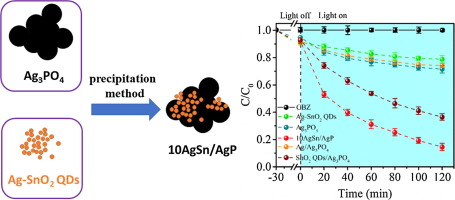Journal of Colloid and Interface Science ( IF 9.4 ) Pub Date : 2018-09-12 , DOI: 10.1016/j.jcis.2018.09.039 Zurui Duan , Lin Deng , Zhou Shi , Haojie Zhang , Hanxuan Zeng , John Crittenden

|
The occurrence of carbamazepine (CBZ) in environments poses a potential risk to aquatic life and exhibits growth inhibition of human embryonic cells. In this work, for the first time a series of Ag-SnO2 quantum dots (QDs)/silver phosphate (AgSn/AgP) composites were synthesized and used as photocatalysts for CBZ degradation. The obtained AgSn/AgP composites showed superior photodegradation efficiency for CBZ removal. The degradation rate constant of 10AgSn/AgP (with 10 wt% of Ag-SnO2 QDs) was almost 8.5, 5.7, 5.7, and 1.9 times as that of Ag-SnO2 QDs, Ag3PO4, Ag/Ag3PO4, and SnO2 QDs/Ag3PO4, respectively. The improved photocatalytic activity could be primarily ascribed to the improved charge separation through a collaborative effect of Ag-SnO2 QDs and Ag3PO4, and in situ photoreduced metallic silver. Electron spin resonance (ESR) measurement and radical trapping experiments suggested that holes (h+), (superoxide radical) ·O2− and (hydroxyl radical) ·OH corporately participated in the decomposition of CBZ. Moreover, a reasonable mechanism for photocatalytic degradation of CBZ over 10AgSn/AgP composites was tentatively proposed. Additionally, eight degradation intermediates were determined by liquid chromatography-mass spectrometry (LC-MS). Toxicity evaluation using the Ecological Structure Activity Relationships (ECOSAR) program revealed that the toxicity of most photodegradation intermediates were much lower than that of the parent compound CBZ. This work not only provides a new technique for preparing Ag3PO4-based photocatalysts with high activity, but also demonstrates that 10AgSn/AgP could be a promising photocatalyst for treating water and wastewaters containing CBZ.
中文翻译:

Ag-SnO 2量子点在磷酸银上原位生长用于光催化降解卡马西平的性能,机理和中间体毒性评估
卡马西平(CBZ)在环境中的存在对水生生物构成潜在风险,并表现出对人类胚胎细胞的生长抑制作用。在这项工作中,首次合成了一系列的Ag-SnO 2量子点(QDs)/磷酸银(AgSn / AgP)复合材料,并用作CBZ降解的光催化剂。所获得的AgSn / AgP复合材料具有优异的光降解效率,可去除CBZ。10AgSn / AgP(具有10 wt%的Ag-SnO 2 QDs)的降解速率常数几乎是Ag-SnO 2 QDs,Ag 3 PO 4,Ag / Ag 3 PO的降解速率常数的8.5、5.7、5.7和1.9倍4和SnO 2 QDs / Ag 3 PO 4, 分别。改进的光催化活性可以主要归因于通过Ag-SnO 2 QD和Ag 3 PO 4以及原位光还原金属银的协同作用而改善的电荷分离。电子自旋共振(ESR)测量和自由基捕获实验表明,孔(ħ +),(超氧阴离子自由基)·O2 2 -和(羟基自由基)·OH共同参与了CBZ的分解。此外,初步提出了在10AgSn / AgP复合材料上光催化降解CBZ的合理机理。另外,通过液相色谱-质谱法(LC-MS)测定了八种降解中间体。使用生态结构活性关系(ECOSAR)程序进行的毒性评估表明,大多数光降解中间体的毒性都比母体化合物CBZ的毒性低得多。这项工作不仅为制备具有高活性的基于Ag 3 PO 4的光催化剂提供了一种新技术,而且证明了10AgSn / AgP可能是用于处理含CBZ的水和废水的有前途的光催化剂。











































 京公网安备 11010802027423号
京公网安备 11010802027423号